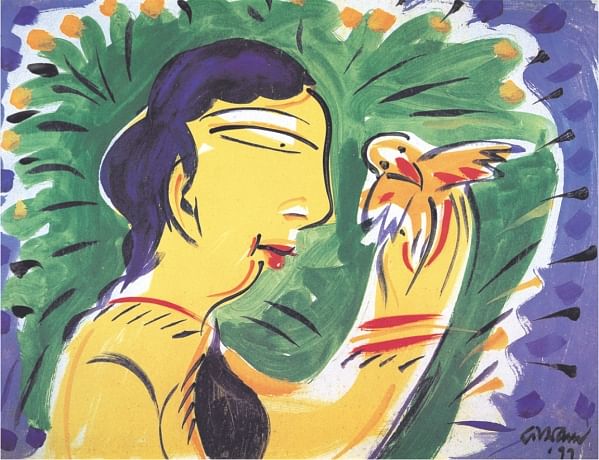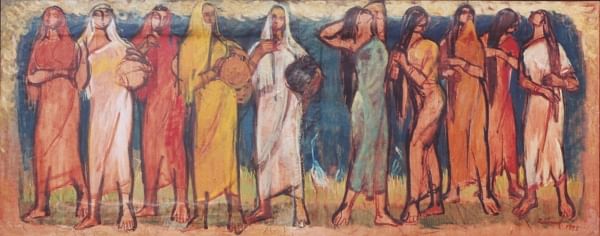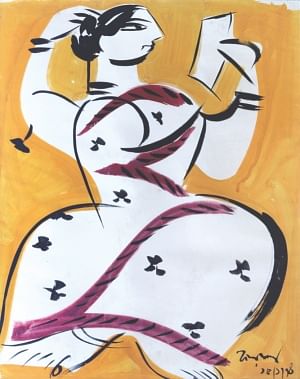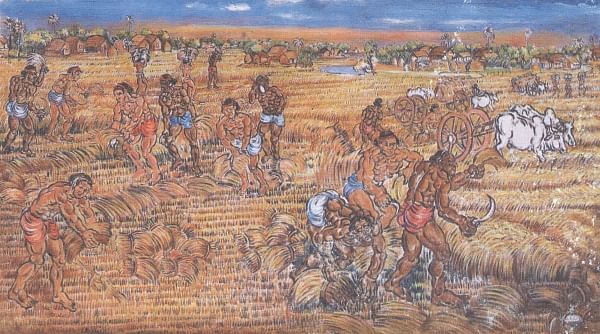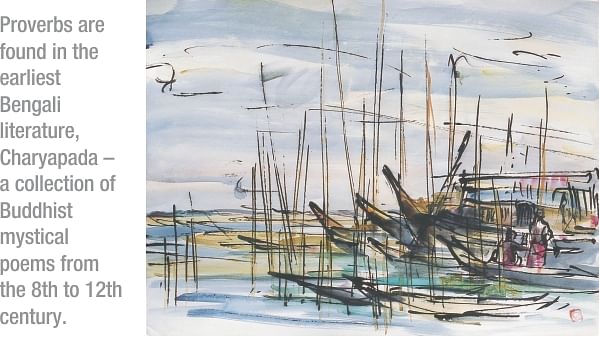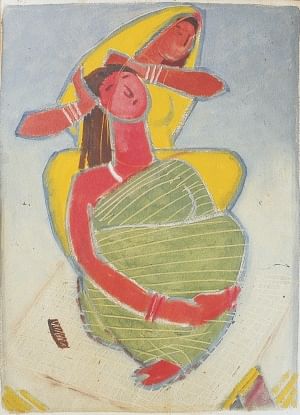| Home - Back Issues - The Team - Contact Us |
 |
| Volume 11 |Issue| 15 | April 13, 2012 | |
|
|
Cover Story
Riddles and Rhymes that Reveal the Past Probad (proverb), bachan, probachan (folk saying) and shilok (riddles) are part of our rich Bengali folk culture. Unlike folk songs, these collections of oral wisdom are almost in oblivion in today's urban society, modernised by science and technology. Yet, the importance of probad, bachan, probachan and shilok remains timeless and reminds us of our unique heritage. Tamanna Khan “Tukumuku gachhta Thirty-year-old Kamrunnahar blushes as she recites the shilok (riddle), standing at the door of her mother's house. Her eyes twinkle with a mischievous smile as the others drill their brains for the right answer. After a few moments, she chuckles and produces the answer, “lal-morich (red chilli).” Kamrun, unlike her friends in the village of Mojlishpur, Shibpur thana, Narshingdi district, has picked up quite a few riddles from her mother Sufia Begum, who is considered a whiz in this field among the local females. Sufia smiles broadly as she is asked to recite some shilok. At first she has difficulty getting over her traditional village shyness. However, as other elderly women of the neighbourhood crowd her shady verandah, she opens up her jhapi (bag). “Akash theika porlo tara, tar theika uthlo paner chara, (A shooting star falls on the ground and gives birth to a betel-leaf sapling. Eat the betel leaf, wise man and tell me its origin. If you can't, eat shaowra (a type of tree) leaves like a goat.)
Sufia teases her audience, while they scratch their heads in bewilderment wondering what can be the story of the origin of betel leaf. Seeing their predicament, Sufia takes pity and recites: “Chhoy mon doi, noi mon khoi (Bring six maunds of curd and nine maunds of pop-corn and water in an aluminum filter, only then will I tell you the origin of the betel leaf)
Everyone breaks out in laughter, except for the city-girl among the crowd. She does not quite get the humour in this traditional leg-pulling game through nonsensical riddles. However, such riddles was once a great source of entertainment in village adda (chitchat). While some are just meant to create confusion and fun like the one recited by Sufia, others like Kamrun's are real brain teasers. Some riddles throw a challenge to the audience or presents a question to them, like the one Sufia Begum has asked. “Lal boron, chhoy choron, pet katile hatey (Red appearance, six legs, can walk if the stomach is severed. How can fools solve this riddle when wise men find it hard?) Riddles are one of the oldest branches of folk-literature. According to professor Dr Wakil Ahmed, who has done research on Bengali proverbs, folk sayings and riddles, these ancient branches of folk-literature can be found in almost all the regions of the country. Based on the dialect of the region, riddles, however, have different names like chhilka, thollok, dhok, dostan, dithan, shilok and so on.
Dr Ahmed mentions that riddles are found in many Bengali epic poems of the middle-ages. In fact, it is not surprising to find that in many cases, riddles have been used to test a person's IQ. In many a Bengali fairy tale, the protagonist often can save his or her life or win a big prize by answering riddles. Even today, many of the best-selling authors, for example Humayun Ahmed's heroines, use riddles to pull the hero's leg or to show her wit. The use of orthography and comparison to different animals, plants, human parts and other objects are common in Bengali riddles, as described by Dr Ahmed. “Kamarer mar maria, panthar maria pa, (Remove the mar in the Bengali word kamar (blacksmith), remove the pa in the Bengali word pantha (goat), remove the bon in the Bengali word lobon (salt), then bring it out and eat) Many riddles are also used to teach morality or pass down knowledge. “Kalidash panditer phaki, (It is a riddle by Kalidash pandit, if you take out three from the three Bengali letters 'shaw', how much is left?) When it comes to moral teachings, Bengali probad (proverbs) are more popular. Proverbs, unlike riddles and probochan and bochon (folk saying) are used more extensively in literature, writings, and even in the court. In fact, many Bengali proverbs and their meanings are taught in school as part of language teaching.
Zakia Ahmed, associate professor of English language at a private university says, “Besides learning proverbs at school, I heard my teachers, elders and even the house help mentioning proverbs in different situations. Like 'nachte na janle uthan banka' is used to indicate a situation when someone tries to pass on the blame for his/her own short comings.” By definition proverbs are short pithy sayings in frequent and widespread use that express a basic truth or a practical precept. According to Dr Wakil Ahmed proverbs are usually expressed in a simple or complex sentence. He explains that proverbs usually carry two meanings; the literal meaning of a Bengali proverb often does not make sense in itself, rather it carries an underlying meaning. He mentions a proverb similar to the English one 'counting your chickens before they hatch'. “For example, if you try to understand 'Gachhe kanthal, gofey tel' (jackfruit in tree, oil in moustache) literally it will not make sense. Rather the meaning of the proverb lies behind the words. This is the case in most proverbs,” he clarifies, “'Porer ghare bonduk rekhe pakhi baa jontu shikar kora' (hunting birds or animals by placing the gun on someone else's shoulder) refers to the characteristics of an opportunist.” Usually, proverbs are not used or read independent of a context. “It is used in speeches and writings. Proverbs are also found in journalistic writings and used by lawyers in court proceedings. Proverbs are a powerful part of language that is used in context. They make the language more meaningful and enrich it. Proverbs strengthen a statement,” Dr Ahmed asserts. Proverbs are found in the earliest Bengali literature, Charyapada – a collection of Buddhist mystical poems from the 8th to 12th century. Dr Ahmed mentions one proverb from Charyapada – “Apona mangshe horina boiri” meaning a deer falls in danger because of its own flesh implying that virtue often invites enemies. Interestingly, the language of this proverb has changed over time, yet it is still very much in use. “However, another proverb, 'doa dudh bate phire jai na' (once the milk is out, it does not return to the udder), found in Charyapada is no longer in use,” he informs. Proverbs are results of people's experiences over years. “For example, 'chor palale buddhi barey' (when a thief escapes, wisdom increases), this has been in use orally for centuries. Stealing has always been there in our society. It is still prevalent in villages and cities. Perhaps this proverb was made during one such (stealing) incident,” Dr Ahmed says, “It implies that people usually comprehend an incident once it has taken place.” It is often difficult to determine the time or period of origination of proverbs. “Researchers like us focus on certain aspects. For instance, the timing can be guessed based on the words used. Such as 'police'; it is an English word. Therefore this proverb was not created before the British period,” explains Dr Ahmed, citing the proverb 'chorer mon pulish pulish' (a thief's mind says police, police) implying the guilty conscience of a criminal.
Mentioning another proverb 'haat na boshte daira kori' (collecting tax before the bazaar is held), Dr Ahmed explains how the Farsi word 'daira' meaning tax and the concept of collecting tax from a bazaar alludes to the Muslim period when the zamindar system prevailed. “In villages, zamindars usually used to lease the bazaar ground and then collect tax from the sellers who came to sell their goods in the bazaar,” he adds saying that this proverb is used when people demand something before a work has been done. In case of proverbs, it is not possible to find out their authors. “It is possible in case of bachan (adages),” says Dr Ahmed, “about agriculture, health, moral and religious teachings.” Bachan and probachan (adages and maxims) are folk sayings comprising of two to ten verses. Unlike Bengali proverbs, the probachan and bachan contain their literal meaning, clarifies Dr Ahmed citing the probachan 'kothai kotha barey, jole bare dhan, baper bari thakle meyer bare opoman' (words begets words, water beget paddy, when the daughter stays at her father's house, she begets humiliation) “The meaning of this two-line verse is what the words express. Words lengthen conversation, this is one aspect of the adage, then there is a type of paddy that grows faster with more water and if a daughter stays at her father's house after marriage, it is looked down by the society,” he analyses. Referring to another probachan, 'meyechele kadar dhela, dhopash kore jole fela' (women are blobs of mud, throw them in the river with a splash), Dr Ahmed points out how adages presents the perspective of the society during the time of creation of the adage. There are numerous folk sayings that provide a picture of the society, its perceptions and way of life. “Be it proverbs or folk sayings they reflect ordinary people's real life experience,” Dr Ahmed says, “Both provide a picture of the society. No doubt these are witty. These express the thoughts and wisdom of the society.” Wisdom, no doubt is passed down through adages, especially in case of agriculture; bachan (maxims) were the farmers' Bible. Sixty-five year old farmer, Haji Abdul Qaiyyum, from Mojlishpur village, recites one of Khona's widely known bachan in his local dialect: “Agrahayon choitre hoile bristi However, since Khona is a household name among the villagers, Sufia presents the same bachan differenty: “Jodi borshe Agone (If it rains in Agrahayan, the eighth month of the Bengali calendar corresponding to September /October, then the king will beg. If it rains in Magh or Phalgun –Chaitra, the last three months of the Bengali calendar corresponding to the winter season, then the kingdom will prosper).
Qaiyyum laments that modern farmers today do not take agriculture seriously and thus no longer learn the adages that dictate the affects of weather or provide crucial sowing advice. “In the old days, we use to sow Aush paddy in the month of Agrahayon. Now Aush is hardly sown. There are so many breeds — Iri and all. They are sown round the year,” he adds. The folk sayings, related to agriculture and weather, are disappearing with time, because of climate change, opines Dr Ahmed. “Agriculture is no longer solely dependent on rain. We have developed irrigation system. Once only one crop was grown. Now three crops are grown in a year. As a result such sayings will not work anymore.” Yet, Khona's bachan had proved to be true in 1999, when after the devastating flood of September-October 1998, it rained late in the month of Magh. That year bumper crop production swept away all fear of food shortage much to the delight of the then Sheikh Hasina government. Although there are many folk sayings like Dak's bachan, a Buddhist wise man and Rabon's bachan, Khona's bachan are the most popular. Her wise words ring in the voices of the common people almost all over the eastern part of the Indian subcontinent - Assam, Bengal, Bihar, Orissa. Some of her adages are also found in Telegu language. According to Bengali legends, Khona was the princess of Lanka (Sri Lanka) brought up by demons. Fate leads her to marry Mihir, son of, Borah Mihir the court-astrologer of Ujjayini's King Bikramadaitya. When the couple comes back and settles at the court of the king, Khona's expertise in astrology surpasses that of her father-in -law and he orders his son to severe Khona's tongue. Thus Khona, which means mute, bleeds to death. Whether the legend is true or not, there is no doubt that Khona was an intelligent Hindu woman of the fourth century, according to Dr Ali Nawaz, author of “Khanar Bachan, Krishi or Kristi”. He argues that Khona is not mentioned in the pages of history because she was against the ruling Hindu Brahmins; rather she followed the atheist pandit Charvaka. In her bachan, Khona not only forecasts the weather, but also reminds farmers of the importance of farming elements and agricultural products such as cows, bamboo, plough etc. Mohammad Zamir in his book 'Anthology of Bengali Proverbs and Bachans' mentions how Khona's sayings about the possibility of heavy showers in case stars can be seen within the halo of moon, came true in 1978, when farmers in Comilla witnessed such an incident. The authors of the bachan are more readily known when their names appear in the last line of the verse, which is called bhonita, informs Dr Wakil Ahmed. However, many folk sayings do not carry bhonita. Zakia Ahmed remembers one that advises on health. “Ate tita, datey noon, kaney kochu, nakey tel “It says that if you eat bitter, brush your teeth with salt, put oil in your ears then doctors will not visit your house, because you will not get sick,” she explains, recalling how her mother used to tell her to follow these rules. Unfortunately, such sayings are hardly in use in today’s urban society. Even in villages, only a few elders can be found who can recite a riddle or an adage. Kamrunnahar's aunt from a neighbouring house rues, “Young people nowadays do not know these. However, what they know, we did not.” “Proverbs, adages and riddles provide identity to a nation. They are part of the folk culture of Bengalis,” says Dr Ahmed, “While urban culture has a global aspect, folk cultures are unique. They are the ingredients of our heritage and carry the cultural value of our nation.” Our fast paced lifestyle with plenty of options for entertainment, our detachment from nature and our modern professions have inevitably rendered the proverbs, riddles and folk sayings irrelevant in our lives. Yet it is interesting to learn and appreciate our past, the stores of wisdom we never knew. The yearning leads us back to our roots, down the dusty, mud road searching for our invaluable cultural heritage, which remains secluded in shadowy verandahs of village homes.
|
||||||||
Copyright
(R) thedailystar.net 2012 |
